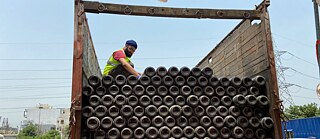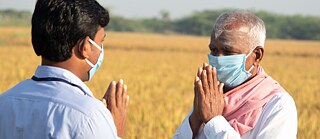Pandemic Perceptions
When “I” Got Replaced With “We”

What do you do, when you cannot go outside? You go inside. A time to reboot, reset and reinvent, the pandemic transformed both: the self as well as the society. Namrata Kohli discovers a new willingness to help and care in India.
By Namrata Kohli
It was the worst of times, and yet it had a silver lining to it – it allowed the milk of kindness to flow and human spirit to shine above everything else.
The COVID-19 pandemic locked us inside. But when you can’t go outside, you go inside. A time to reboot, reset and reinvent, the pandemic transformed both: the self as well as the society. Sometimes a crisis gets the better out of people. The years 2020 and 2021 were headlined by acts of social good, philanthropy, going beyond mandate and a call of duty, rising above constraints as India battled the deadly pandemic.
People opened their wallets, threw open their kitchens to share food, and most importantly, their hearts to help anyone and everyone in distress. Many continued to pay wages to their service providers even though they themselves suffered pay cuts and job losses.
When hospitals were choked to capacity in the city of Nagpur in Maharashtra, an 85-year-old man vacated his bed in the hospital for a 40-year-old, and died within three days. In Gujarat, two doctors returned to work just a few hours after cremating their mothers, to “save other lives”. Caste and creed became irrelevant as people from different faiths came forward to perform the last rites of the deceased from other religions.
Community calling
When “I” gets replaced with “we”, even illness becomes wellness. In uneasy times, leaning towards community and the feeling that “we are all in it together” brings a psychological comfort. Sharing grief can lead to collective healing.At a time when government resources and health systems were overwhelmed, India’s social entrepreneurs, corporates and communities stepped up every effort to help solve the crisis. People helped one another, be it in cash or in kind, providing ration, pooling in money, contacts and resources to help fetch medicines or access hospitals and infrastructure.

Gurudwaras in the National Capital Region of Delhi got the supply from as far as Baddi in Himachal Pradesh, Haridwar in Uttarakhand, Jaipur in Rajasthan and Ludhiana and Rupnagar in Punjab. The sprawling ashram of Radha Soami Satsang Beas on the outskirts of South Delhi in Chhatarpur was turned into a quarantine facility with 10,200 beds. The Radha Soami kitchen known to “feed” people, the temples, the Gurudwaras and other religious places in India will go down in the history books as also places which became relevant and meaningful in India’s fight against the corona virus. Likewise, schools, colleges, stadiums, community centres, hotels and many institutional areas got converted into quarantine centres.
Corporate India battles corona
Corporate India left no stone unturned in using its organisational muscle to ensure the wellbeing of employees, partners, and communities. They supported the government and state machineries in providing oxygen, facilitating the vaccine drive, importing healthcare equipment like oxygen concentrators and ventilators. Companies like HCL and others helped mitigate the oxygen crisis by importing 6,000 oxygen cylinders and 21 ready-to-use oxygen plants, which helped to compensate for the prevailing lack of oxygen.In view of the many deaths, corporate India did not stay behind in lifting the morale of their employees. The company Reliance, for example, offered full salary for five years to the families of deceased employees, as well as paying for the children's education. Many Tata group companies such as Tata Steel and Tata Motors said they would continue to pay salaries to the deceased employee’s families till the retirement age of 60 years. Other companies like Borosil and Muthoot Finance offered full salaries for two years; software companies like TCS and HCL Technologies offered insurance cover, while many others like ICICI Lombard granted employment to the deceased staff’s spouses.
Stories like these demonstrate how India’s social development sector plugged in the many gaps that were left unattended due to logistical and operational difficulties in places, ensuring last mile delivery of food, money, vaccines, equipment especially to the poor, marginalised and rural communities.
A change in worldview
Overall, people have become more humane, sensitive and sensible and care less than before about power, status and money. Kindness in the form of adopting pets and philanthropy is visible. The concept of giving is finding more takers especially amongst youngsters.However, people need to come out of an “event based” or “religious charity” system and share resources on a regular basis, making it a way of life. A wise person working in the social development space in India once said: “When there is poverty as the single biggest disaster, why wait for a flood or a famine to happen in order to donate or respond to it. And it is not just money, one can share one’s time and skills with others in order to contribute towards society.”

Pandemic spurring personal growth
At an individual level, a record number of people turned to learning as a source of hope, growth, and resilience amid economic uncertainty. The pandemic led to a more proactive rather than a reactive approach to one’s own health. Early diagnosis, regular follow ups, stocking home with necessary medical equipment and medicines – people are actioning all of this. It's back-to-basics as people have started adopting a more nature-compliant lifestyle. Bicycles relived a boom and electric cars are set to take-off in the new world order which is geared towards green mobility. COVID-19 has changed the tenor and complexion of weddings with couples choosing to swap the grand multi-function celebration for leaner, simpler and more sustainable formats. The pandemic has also pushed Indians to recognise the value and worth of traditions, heritage and ancient wisdom.Like someone said: “You need to be buried deep in the dirt before you can find your bloom.” So post pandemic we will be, hopefully, in a better state of one self as individuals, but also as society as a whole.
This article was published first in the journal Politik und Kultur no. 02/2022.